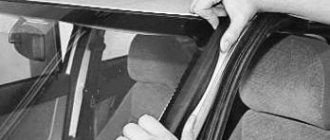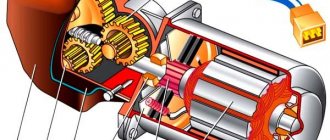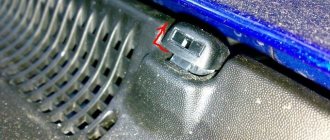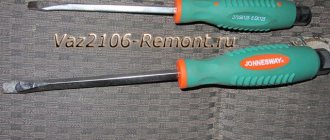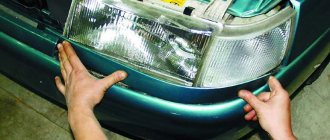Already on new cars of the VAZ 2110 series, buyers noted the insufficient effectiveness of noise insulation and wind protection by rubber on the doors. Therefore, there is no need to talk about used cars.
Over time, creaking and rustling noises appear, and the driver and passengers experience discomfort from the cold seeping through worn-out seals. Plus, loose fitting of the doors leads to the appearance of moisture inside the cabin during snow or rain.
It would seem that such an insignificant element as a seal, but how many problems it can cause in case of wear or mechanical damage.
The seals at the bottom of the doors, near the thresholds, are subject to the greatest wear. Therefore, every buyer of a used VAZ 2110 or the owner of a rather old car must first replace these same rubber bands.
Appearance of the gum
Functions of the door seal on the VAZ 2110 and its independent replacement
If even the owners of the new “ten” noted insufficient noise and wind insulation of the door rubbers, then what can we say about well-used cars.
The door seals of the VAZ 2110, worn down by time and use, no longer meet even the minimum requirements that are imposed on them by not so demanding consumers of AvtoVAZ products. Not only can you hear every creaking and rustling sound outside the cabin, but the driver’s left side and knee are “frozen,” and the passenger’s right is “frozen” by the headwind, which freely penetrates through loosely fitting doors and sagging rubber bands. To complete the picture, you should also add raindrops penetrating into the interior.
Door seal per meter
And yet, undoubtedly, any seals wear out, especially at the bottom, in the threshold area. Therefore, the isolation of the interior from external influences can be saved either by replacement or significant modification.
Selecting a seal, correct fastening of the material
Having decided to apply a certain layer of sealing material to the door of your car, in no case should you buy the first suitable material you come across, since only a certain additional seal is suitable for each car.
Therefore, it is necessary to familiarize yourself with all the information regarding the material from which the car doors are made, and only after that will you be able to purchase components. The RKI-19 brand material is suitable for Lada Kalina, but this sealing material is absolutely not suitable for installation on Lada Priora. To install on Priora, you will need a little more material than on RCI-19.
The right choice allows you to increase the life of the car and significantly reduce the level of noise entering the Priora’s interior. Installing additional seals on the doors allows you to perform a kind of “sealing” of the car interior and protect door locks and hinges from various contaminants that can easily pass through the door gap.
Selection of replacement
You won’t find any kind of advice for naive and gullible car owners on the Internet. Some suggest installing window seals on the VAZ 2110 instead of rubber bands intended for this model, others suggest inserting tubes from droppers inside. In general, there is no limit to skillful imagination.
We will try to focus on the most acceptable options, with proven effectiveness in practice.
So, to replace rubber bands you can use:
- a ready-made set from the manufacturer - designed specifically for the VAZ 2110. These are mass-produced rubber bands that fit perfectly on all doors. They are double-circuit and allow for additional sealing;
- measured VAZ rubber bands. That is, on sale you can find both ready-made, “soldered” rubber bands for each door, and a rubber band per meter for the same purpose;
- seals for Priora - according to experts, they are even better. Firstly, they are three-chambered, with a steel strip for fixation. Secondly, they are of higher quality, “hold” their shape longer, and do not wrinkle as much; Priorovsky door seal
- It is also possible to install rubber bands from GAZelle.
Tip: Before choosing a seal, you need to very carefully measure the internal length of the rubber bands on the front and rear doors. It’s better to take a little more if you’re not using a “native” set, because shortening is always easier than sharpening.
In addition, if you plan to modify it for tighter insulation, you will also need a tube for additional door sealing, about 8 mm in diameter made of silicone or polyurethane.
For fixation, disposable pins and glue are used.
Dismantling
After purchasing everything you need, you can first begin dismantling and then installing a new seal. The first stage is removing the plastic facing panel from the threshold. This is done using a regular flat-head screwdriver. Just try to do everything carefully, without damaging the plastic clips that secure the panel.
This is followed by the removal of old rubber bands. This is done by tearing it off, then removing the residue using available tools. If you need to remove the remaining glue or small debris, use a solvent (be careful that it does not dissolve the paintwork of the car).
Next, you need to clean the entire doorway from dust and various contaminants, paying special attention to the lower parts. You can do dry cleaning with a brush and vacuum cleaner. If you still need to wash it, let the surface dry thoroughly before installing the rubber bands.
Installation
This work, in principle, is not too difficult; it can be done even without special training. Just take into account that the installation of the seal and the simultaneous modification of wind and noise insulation must be carried out carefully and meticulously, then you will ensure greater interior comfort for several years to come.
The installation is carried out according to the following algorithm:
- Even if you have previously measured the seal seat, do it again, following the popular wisdom that it is better to measure seven times;
- Cut the seal to the required length with a small margin (a couple of centimeters). Of course, if you bought a ready-made “ten” set of rubber bands, then ignore these two points;
- Inside the seal, insert the polymer or silicone tube that you have. Accordingly, its length should also correspond to the elastic band. This tube is designed to give elasticity to the entire insulating structure and create a better fit of the rubber bands, thereby protecting the interior from unnecessary additional “ventilation” and unnecessary sounds;
- Glue the side curly seal at the bottom;
- A solid rubber band can be worn anywhere. And for measuring, it is best to choose a starting point between the door awnings (or about 30 cm from the bottom of the threshold). Whether you move the installation up or down does not matter;
- It is necessary to push the figured profile all the way down. This is done only with the help of a rubber or wooden mallet (hammer);
- When you walk around the entire perimeter, you will probably find that there is a lot of material. The insert element (tube) must be cut exactly end-to-end, and the seal must be cut in such a way that there is slight deformation of the adjacent areas. Thus, there will be no “siphoning” through the joint;
- Install the piston, remount the plastic sill trim;
- Carefully and tightly glue the second contour along the edge of the door. Let it dry.
Almost immediately when closing the door you will hear a softer dull sound. And while driving you will not hear annoying noises and whistling of the cold wind penetrating inside. After a while, you see, you will forget about the pain in your previously cold left knee.
Additional seal
If you have completely replaced old rubber bands with new ones in all doors, then no additional insulation is needed. But in cases where you do not want or do not have the opportunity to do this immediately, and the old rubber bands have become crushed and worn out, you can install additional VAZ 2110 door seals as a temporary measure.
It could be a thin tube for thermal insulation. These are used in refrigeration equipment, etc. The material is a bit like black foam rubber, but denser. You may come across advice - to use meter seals for windshields in this capacity, but this is impractical. Firstly, it is quite difficult to find one, it is much more expensive, and is not easy to install - it is difficult to achieve a high-quality tight fit. seal
However, regardless of the material chosen, its installation is no different.
As a rule, additional insulation of doors is carried out only in their top and rear parts. If there is a strong need - and in the front part, you just need to be especially careful in the area of the hinges so that the material does not interfere with the normal closing of the doors, otherwise some on the forums complain that after such actions problems arose with closing the doors.
It is irrational to install anything additional in the threshold area. Dirt and water will accumulate there faster, and then corrosion, rust, holes...
The additional seal is simply glued to the body (not to the door), close to the existing one. When choosing a glue, make sure that it does not react with the paint surface of the car.
After gluing, close the doors and check whether the seal is coming out. If necessary, it is carefully trimmed.
Seal fastening methods and their alternatives
As practice shows, additional door seals can be easily replaced with a regular rubber hose. For installation you will need superglue or double-sided tape and a surface degreaser. First you need to cut the pipe into several parts. After this, the first part is taken, degreased and secured with superglue in the right place.
Then a tube is glued on top, the tube is fixed on the side of the windshield, then it is pulled towards the rear door. Installing additional gasket may make it difficult to open and close, so additional door adjustment will be required.
Installing the gasket takes approximately two to three hours. Additional seals are an excellent solution for eliminating noise and humidity in the Priora’s interior.
In some cases, a special sealant can be used as glue; it is more suitable for installation than glue. With its help, you can not only secure the seal tightly, but also protect the car from rust. The first changes in the interior are noticeable immediately after installing the seal on the car. After installation, the cabin becomes quiet and warm, and street noise practically does not penetrate. In case of rain, the seal prevents moisture from entering the interior.
The second most acceptable seal option for most motorists is the K-FLEX pipe seal, which can be purchased from a technical service. Its fastening is carried out by analogy with fastening a conventional rubber hose. After its installation, the doors will be sealed, but over time the pipe will become more flexible and the doors will close again easily and the interior, thanks to the sealant, will be warm, dry and quiet.
We improve the seals on the doors of the VAZ 2110
Already on new cars of the VAZ 2110 series, buyers noted the insufficient effectiveness of noise insulation and wind protection by rubber on the doors. Therefore, there is no need to talk about used cars.
Over time, creaking and rustling noises appear, and the driver and passengers experience discomfort from the cold seeping through worn-out seals. Plus, loose fitting of the doors leads to the appearance of moisture inside the cabin during snow or rain.
It would seem that such an insignificant element as a seal, but how many problems it can cause in case of wear or mechanical damage.
The seals at the bottom of the doors, near the thresholds, are subject to the greatest wear. Therefore, every buyer of a used VAZ 2110 or the owner of a rather old car must first replace these same rubber bands.
Appearance of the gum
Installing a trunk seal on a VAZ 2107
And so, when replacing the sealing rubber of the trunk of a VAZ 2107, I propose to start by evenly distributing it along the entire perimeter, lightly putting it on the flange.
It is best to connect the trunk seal of a VAZ to the rear, not the front. If you do not do this, then when driving in the rain, water may seep into the luggage compartment.
At the bends, squeeze the elastic slightly, but be careful not to form wrinkles. After the elastic is evenly distributed, we finally stuff it with our hand or, for example, with a mallet. You can insert a piece of soft tube into the joint.
What to choose?
Sometimes you are amazed at the imagination and thoughts of those who are trying to save money on car repairs. If we talk about rubber seals, some advise using drip tubes instead, others go the other way, inserting window seals.
Do not follow such advice under any circumstances. They won't lead to anything good.
There are several truly correct and effective options, which we will introduce you to using the table.
Option
Peculiarities
Ready-made kits from the manufacturer
They are designed specifically for the VAZ 2110 model. These are mass-produced rubber bands that fit perfectly on the dozen doors. Their design is double-circuit, which allows you to install additional seals if necessary.
Measuring rubber bands for VAZ
In stores you can purchase ready-made or soldered seals for each door. Or a solid tape, from which they will cut you a piece of the required length
Seals from Priora
Experts believe that these are the most effective and reliable seals. This is due to the three-chamber design with a steel fixing strip and high quality. These elastic bands do not wrinkle and keep their shape perfectly.
Rubber bands from GAZelle
A frequently encountered option that has similar characteristics to the standard elements for the dozen. The price is about the same
When choosing the length of the required piece of seal, measure the internal length of the installed rubber bands on both doors separately. Take it with a reserve, because you can always cut off the excess.
The fixing elements should be caps and high-quality, effective glue. When purchasing the rubber itself, they will tell you which glue is best to use.
Removal
When you have purchased the required number of seals, you can begin to work.
The first step is to remove the old rubber elements, after which the installation of new parts begins.
Let's tell you more about the dismantling procedure.
- Remove the plastic trim panels installed on your vehicle's door sills. To do this you will need a thick screwdriver. Remove carefully, being careful not to damage the plastic caps. But it’s better to buy new ones in advance if you can’t carefully dismantle the threshold.
- Now remove the old pieces of rubber from the seats. Simply tear off the sections that are torn off by hand.
- Remaining rubber can be cleaned off with any available tool. Only be careful with sharp objects so as not to damage the metal and paint layer.
- Very small residues and traces of glue are removed using solvents. Make sure that the solvent you choose will not damage your paintwork.
- Go over the doorway with a vacuum cleaner, remove all dust and dirt. Take special care to clean the bottom part. If wet cleaning was used, wait until everything is thoroughly dry.
Upcoming work
Installation
This process cannot be called complicated. You are not required to have any special training or extensive experience. Although you should at least be able to handle glue.
Working with the back door
Each stage is performed consistently and carefully to achieve the desired result and create comfort inside the cabin.
- Even if you have already measured the required length of the seals for your doors, we advise you to do it again. Anything can happen.
- Cut the required length, plus leave a couple of centimeters of reserve. Although if we are talking about a ready-made set of rubber bands, you won’t have to cut or leave anything. Skip the first two points.
- Insert a tube made of silicone or polymer inside the sealing tape. They are sold everywhere, so there should be no problems finding them.
- The length of the tube must match the length of the rubber. This tube will serve to create the necessary elasticity and allow the elastic to press more tightly to the door. This way, ventilation gaps will not appear, and the cabin will become much quieter.
- A shaped side rubber seal is glued to the bottom.
- If the tape is solid, you can start putting it on from either side, as is more convenient for you.
- If it is a measuring rubber band, then start from a point between the door overhangs, or 30 centimeters from the bottom of the threshold. Moving up or down is a personal choice for each master. There is no difference here.
- Push the figured profile all the way down. To do this you will need a rubber or wooden hammer. He's a mallet.
- When the seal is installed around the entire perimeter, an extra piece will be revealed. Cut the tube straight and end-to-end, and make the elastic itself seem slightly deformed. It's like you tore it off by hand. This will avoid the unpleasant phenomenon of siphoning through the joint.
- Replace the pistons; if some were damaged during removal, replace them with new, intact ones.
- Replace the plastic cladding removed from the threshold.
- The second contour of the seal is glued along the edges carefully, but as tightly as possible, after which time is given for the glue to dry completely.
Almost immediately you will feel the difference between the old and new seal. This is a useful exercise that allows you to get rid of unpleasant sounds, knocking, whistling and cold air flowing directly onto your feet.
Additional measures
Some car owners believe that the efforts of standard seals are not enough to provide the necessary comfort and silence in the cabin. Therefore, they decide to install additional rubber bands.
An additional seal is installed only if the old ones are worn out, but you do not want or cannot replace them completely. If you replace rubber bands, there is no need to install additional elements.
Thermal insulating tubes, which are used in refrigerator designs, often act as additional seals. The material is somewhat similar to black foam rubber, only its density is higher.
Additional sealer
Sometimes an additional element is the seal used for the windshield. Although from a practicality point of view this is not the best option. This is explained by the difficulty of finding material and the inconvenience of installation - the material is difficult to adhere to, and it is difficult to achieve a high joint density.
Regardless of the material chosen, the installation procedure always looks approximately the same:
- Additional insulation is installed on the top and back of the doors, and sometimes on the front. In the latter case, be careful with the hinges so that the material does not interfere with closing the doors;
- There is no point in placing additional insulation in the area of thresholds. Dirt accumulates there very quickly, which will ultimately lead to corrosion, rust and other problems with the metal;
- The material should be glued to the body, but not to the doors. The additional insulation should be located tightly in relation to the rubber bands already installed on the door;
- Choose your glue carefully. Some compounds may begin to destroy the paint layer;
- When you have completed the installation, try closing the doors. Sometimes the material comes out a little. In this case, it is enough to simply trim off the excess pieces.
The presence of seals makes driving your car more comfortable and enjoyable. These rubber bands have a positive effect on the level of sound insulation. This is important, given the effectiveness of the standard Shumka provided for the VAZ 2110.
We strengthen the seals 2110 (can also be used for other VAZs).
Today we are talking about seals. I turned the spit slowly for probably a month or so. There is a lot of different information on the Internet, for example, sticking door D-shaped seals, installing Priora, 3-chamber, gazelle, silicone hose, etc. The best option for me is the Priorovsky ones. I did just that, bought a set of seals 2170 for 4 doors. The trunk has the original 2112 and the original gutters. I installed the driver's one first for testing.
Pros:
- looks more solid from the outside; - presses better; — two-circuit; — principle of operation of the accordion; — the composition looks, feels, compresses/decompresses better.
Minuses:
— wide, fits into the spacer with the door trim (the trim is not standard). On any bumps or irregularities the creep is significant; — does not quite fit the ceiling trim, parts of the interior trim. The body is visible from above, the side of the seal sticks out, which should lie down and cover the interior elements.
Operating principle of seal 2170. The outer part/second chamber is pressed, working. The first chamber is in the form of a hose, a return amplifier. It is compressed by an accordion at the bottom of the reinforcing hose of the first chamber. More air layers are obtained, more material, more pressing forces. We get warmer, quieter, resource.
The disadvantages turned out to be significant for me specifically. Overall, it was bad, I didn’t like it... A week later I went back to the market and replaced 3 2170 seals with 4 original 2110 ones.
What is bad about 3-chamber seals (type 2109) in my opinion, not counting the fact that they are unlikely to block the ceiling lining. With strong compression, excessive deformation; cramming more does not mean better. Everything has its own elasticity threshold. While new, everything is great, but the resource will be small. Moreover, it depends on the execution, form, location. The outer part should not be stronger than the inner, or be equal. Shapes of working angles, thickness, etc. The outer chamber takes the shape of the door more, the inner chamber increases the pressure/return with slight deformation. Which is what was done at Prior. This can be seen after a little use, when the seal presses a little, and not when it comes from the store.
Since the native 2110 is logical that they lose to the 2170, it cannot be otherwise. AvtoVAZ, although it is moving in small steps, is still moving. It was necessary to somehow strengthen them... The idea was born immediately.
In the corners of 2110 there are trimmings of seals/porous rubber from the factory so that there is no breaking bend in the upper corner of the door.
The intended angle itself is marked with a dot of paint.
I took my photos with these angles and points. Then I sent it to my phone, but suddenly the body died. I had to take photos from IvanVRN36.
Since such a sealing harness/cord made of porous rubber is classified as a rubber-technical product, finding it at least in our city is practically equal to 0. By the way, I asked a question about this harness/cord, there is also a photo there: www.drive2. ru/communities…orum/465065382076482147?m
I started looking in stores for what I could use. Call different offices in the city for all kinds of sealants, products, etc. It was necessary to have something like a cord shape, elastic, frost-resistant. At first everything was unsuccessful, I was already desperate and wanted to install it as is. Then, once again, while looking for a suitable material in the store, I accidentally “stumbled upon” Vilaterm!
Of course, this is not exactly what we would like for an ideal, but as an analogue it was 100% suitable.
"Vilatherm"
- an environmentally friendly material, made using modern technologies from foamed polyethylene, for insulating and sealing joints of prefabricated elements of building envelopes. High-quality, elastic material, which, due to its increased (for this type of material) density, can withstand multiple cycles of tension and compression, which allows it to work perfectly in expansion joints of various designs. Fine-celled, lightweight white material with closed pores, made from high-density polyethylene by foaming with a butane-propane mixture. It is characterized by a unique combination of physical-mechanical, thermophysical and acoustic properties. It is produced in the form of bundles and round pipes of various diameters, 3 meters long.
Of course, everything is beautifully described in the advertising description, but after excessive compression/overcoming the elasticity threshold of the tourniquet, you understand that it will not withstand prolonged heavy loads for long. What they honestly write about in the technical specifications, and the tubular version exists only in large sizes.
I immediately bought the sizes, diameter in mm: 6, 8, 10, 12.
This is what vilatherm looks like in a piece of the new seal 2110:
Initially I made 12 mm.
At first it’s not difficult, then the friction increases and the wedge gets bigger and bigger. Finally, use a soap solution, sharpen the initial tip, and smooth it out. Preferably together.
12 mm
— After installation in the doorway, naturally the door did not want to close just like that) It closes with force from the outside, but there is a lot of tension on the door. It opens as if the handle is being pulled out, the door is opening) When closed, you can see that the door sticks out a little. Vilatherm material is too dense. Well, in the technical specifications it is written that the elasticity is 0.5 MPa = 5 kgf, but it is not written for what area, this is still a lot even if per cm2. Although in other sources it is 4 kgf, but still a lot. If you can still close it from the outside, because the force arm is large, then the handle will fly off from the interior faster) The shoulder is shifted to the hinge axis, the force is small. Here you either have to ask someone to close it from the outside, or not at all) In general, 12 mm disappears immediately.
10 mm
— Then I changed it to 10 mm. The situation is similar, a little easier. But he did it in 10 minutes. It fit into the seal easily. Although the seal itself, together with the vilatherm, will shrink, but not by much. Leaving it like that is not an option.
8 mm
- already more interesting, but relatively harsh. Left it to shrink. Improvements in Shumka are felt immediately (the doors are glued). Only the driver's with vilatherm, the rest with old seals, empty. Of course it’s not wow, but there is an effect compared to other doors. Moreover, the driver's side is closer. It’s not just that it is written in the technical specifications that it is a heat and noise insulating material. I parked the car. Check in three days. In principle, it has become quite good, it closes easier/softer. Relatively low stress on the door compared to larger diameters. In fact, there cannot be normal pressure without tension on the door. The door closes tighter just with a new seal, even with 2170. The first couple of days. I didn’t stop at 8 mm; everything is learned by comparison. I pulled the vilatherm out of the seal; it formed a small chamfer in the places where it was pressed. That is, it was completely deformed, and this is a minus, of course.
6 mm
— the difference didn’t really change, it became easier to close at a pressed level of 8 mm. And there’s not much point in 6 mm, if only in the role of additional relatively small heat and noise insulation.
Stock
— The door is a bit tight even without everything, new seal.
In general, I left it at 8 mm, a certain balance.
Next is the passenger front door. I thread the 8 mm, close the door, and the immediate diagnosis is not enough! Why? Because all cars are different) Just like adjusted doors on the same car, there are no cars like engines so that they hit each other at zero. One door presses a little harder, the other weaker. We go the other way, remove the old rubber band and look at the operating range of a particular door. We take a size slightly larger than the range, just as the service life extender for the 2110 Vilatherm seal is not suitable due to its properties. This means we just need a clamp on the door without any extra effort. For the rear door, after removing the old seal, 10 mm fit. Having set it with 10 mm, I guessed right away. Everything is as it should be.
6 mm fits tightly into the gutters, but I don’t see any point in threading anything there at all.
What remains is the trunk, which I haven’t gotten to yet; the maximum size that fits is 10 mm. That is, the diameter of the new seal is 10 mm. I think 8mm should be fine.
— heat and noise insulation; — better pressure; - very cheap; — possibility of partial repair of old seals.
- too hard for such purposes; — lends itself to deformation under prolonged load due to its rigidity; — the effect decreases with small diameters; — when threading small sizes, the tourniquet in the seal lies like a snake/zigzag in different positions, hence the spread across the seal. In one place there is vilatherm, but in another it seems to be absent. It turns out that in some places he comes under pressure, but in others not so much.
Vilatherm is not very suitable as a dynamic sealant. It is advisable to do it across the entire diameter of the seal, but then the door will probably not close and it will take more time to thread it through. The optimal size is 10 mm, since the seal will compress 50% exactly. Ideally, you need a material that is less dense and has a higher elasticity threshold. Since it is not so easy to find such a material and even a suitable shape of a bundle/cord/pipe of various sections, vilatherm is the only similar, cheap and affordable option. Of course, it won’t add much to the return elasticity of the seal, but it will improve the clamping and heat and noise insulation.
P.S.
I traveled for several days. I advise everyone to install it for the purpose of noise insulation, the effect is immediate! Quieter, especially if the doors are not empty. Seals are a weak/open area, especially if they are old and pressed/worn. It doesn't matter if it's a pelvis or not. You can even do it without necessarily pressing. The cross-section can be calculated so that when the door is closed, the vilatherm will simply be inside like a Shumka. Those who roll the car with a vibrating brush, etc., make noise on the seals with a vilatherm 200%.
Source
Door seals VAZ 2110
When developing domestic cars, due attention was not paid to their comfort; extraneous sounds are often heard in the cabin and moisture leaks are possible during precipitation. By replacing the door seals of the VAZ 2110 and slightly modifying them, you can achieve better sound insulation performance. Serial rubber products intended for sealing the interior, as a rule, are not of high quality. Often the problem arises not only with the double-circuit seals of the doors themselves, but also of the lowered side windows. This is due to the low quality of polymer materials and rubber from which these elements are made. Errors during their installation on the conveyor, as well as deformation during prolonged and intensive use, are also possible. The work of restoring the tightness of the interior is simple and will not require much time even for an untrained worker.
Doors Lada Priora
If we talk about Priora doors, it is worth noting that the doors have a rather problematic design. First of all, this directly relates to the fastening of the door itself, which becomes loose during operation, and an unpleasant sound appears when closing. To fix these problems, Priora has to remove the trim and install the door fasteners twice.
A common problem is an unpleasant sound when the door lock is activated. To eliminate it, you will have to put special rubber pads on the locking levers.
Replacing glass frame seal elements
External polymer elements are gradually destroyed under the influence of moisture, solar radiation and dust and need to be replaced. The step-by-step guide for replacing seals is as follows:
- dismantling old elements using a screwdriver, being careful not to damage the coating,
- removing dirt under the old linings and wiping the seats with a rag,
- We install new seals in place, while trying not to hit or apply much force.
Having completed all the work on one door, we move on to the next one, considering that their design is similar, then there are no special features in them. This is how we consistently eliminate natural ventilation of the car interior. Photos with step-by-step operations allow you to perform all actions quickly and get good results.
Additional operations to eliminate noise in the VAZ 2110 interior
Statistics show that the majority of drivers of Russian cars are not satisfied with the increased noise in the car. This is caused by the use of low-quality rigid polymer materials and insufficiently reliable fasteners. Therefore, reassembling the interior of even a new car is the most frequently requested service at many service stations. All work can be done with your own hands if you carefully study the instructions for carrying out the entire necessary cycle. The body can be properly isolated from extraneous noise only through complete disassembly . The panels are removed, and polymer or sponge inserts are glued in the places where they meet, which will prevent knocking or other sounds from occurring. The price of materials and work is relatively low, so the total cost of work will be acceptable.
View of the improved doorway of the VAZ 2110
A car improved in this way becomes more comfortable and convenient to use, both in the city and on the highway. A high-quality replacement of the VAZ 2110 door seal eliminates aerodynamic noise and moisture leakage during precipitation into the car interior.
Additional door seals for VAZ 2110
Door seals have a significant effect on the sound insulation of a car. To eliminate wind noise in the cabin, you can modify the door seals or install additional ones.
In this article we will talk about an additional set of seals. Everyone knows what the gaps between the doors of foreign cars are, 1mm-2mm maximum. On my 11th, the gaps in some places reach 5mm. On the Internet you will find many ways to modify the door seals of the VAZ 2110, or maybe try installing additional ones?
How to install
The installation procedure should not cause problems, since it is quite simple and even a beginner can perform it. Although you still need to know how to use glue. It is also necessary to install the seal carefully and carefully, this will allow you to achieve comfort in the cabin for a long time.
To correctly install VAZ 2110 door seals , the following steps should be taken:
This procedure will significantly improve the noise and sound insulation of the car interior.
After installing the new seal, passengers and the driver will immediately feel changes for the better. Extra noise, whistling, knocking will disappear. It will also become warmer, since cold air will no longer penetrate inside and blow through your feet.
Stories from our readers
“Fucking basin. "
Hi all! My name is Mikhail, now I’ll tell you a story about how I managed to exchange my two-wheeler for a 2010 Camry. It all started with the fact that I began to be wildly irritated by the breakdowns of the two-wheeler, it seemed like nothing serious was broken, but damn it, there were so many little things that really started to irritate me. This is where the idea arose that it was time to change the car to a foreign car. The choice fell on the melting Camry of the tenth years.
Yes, I had matured morally, but financially I just couldn’t handle it. I’ll say right away that I am against loans and taking a car, especially not a new one, on credit is unreasonable. My salary is 24k a month, so collecting 600-700 thousand is almost impossible for me. I started looking for different ways to make money on the Internet. You can’t imagine how many scams there are, what I haven’t tried: sports betting, network marketing, and even the volcano casino, where I successfully lost about 10 thousand ((The only direction in which it seemed to me that I could make money was currency trading on the stock exchange, they call it Forex. But when I started delving into it, I realized that it was very difficult for me. I continued to dig further and came across binary options. The essence is the same as in Forex, but it’s much easier to understand. I started reading forums, studying trading strategies. I tried it on a demo account, then opened a real account. To be honest, I didn’t manage to start earning money right away, until I understood all the mechanics of options, I lost about 3,000 rubles, but as it turned out, it was a precious experience. Now I earn 5-7 thousand rubles a day. I managed to get the car buy after half a year, but in my opinion this is a good result, and it’s not about the car, my life has changed, I naturally quit my job, I have more free time for myself and my family. You’ll laugh, but I work directly on the phone)) If If you want to change your life like me, then here’s what I advise you to do right now: 1. Register on the site 2. Practice on a Demo account (it’s free). 3. As soon as you get something on the Demo account, top up your REAL ACCOUNT and go to REAL MONEY! I also advise you to download the application to your phone, it’s much more convenient to work from your phone. Download here.
Additional door seals for VAZ 2110
One of the articles (“Upgrading the seals of the VAZ 2110”) has already talked about how you can eliminate wind noise in the cabin by upgrading the standard door seals. In this article we will talk about installing an additional set of door seals on a VAZ 2110.
To improve the effect of door seals, the gaps between them and the metal of the door should be no more than 1-2 mm, while on VAZ cars of the tenth family the gaps sometimes reach 5-7 mm.
In order to reduce wind noise in the interior of a VAZ 2110 car, you can try installing additional door seals made of various materials.
The first of these methods is FLEX - tube.
Most often, the FLEX tube is found in a store that sells and services climate control equipment. To attach the FLEX tube, it is best to use glue or double-sided tape. Before installing the FLEX tube, it is important to degrease the surface.
One FLEX tube needs to be run along the top (from the bottom of the windshield towards the rear door), laying it along the edge of the rear door (photo below).
In the space between the doors it is better to glue FLEX - a tube from the top to the door lock. There is no point in gluing an additional seal on the door, since when opening and closing the doors you will catch it with your hand, and gradually it will come off anyway.
You can do it differently: replace the factory door seals of the VAZ 2110 with seals from LADAPriora. Similar seals from LADAPriora have a double chamber, which has a positive effect on the tightness of the doors.
Description for the diagram above:
- Red color - glue the FLEX tube directly to the body;
- Green color – glue the rubber seal for the doors;
- Blue color – install door seal from LADAPriora.
You can close the cracks and gaps between the doors of a VAZ car of the tenth family using one of the following methods:
Comparison of foreign cars and Lada Priora
First you need to understand why you need to install door seals. The sound insulation of any foreign car and the Lada Priora has a large number of differences. First of all, it should be noted that the foreign car has a better shape, the car structure and gaskets are installed much better. The desire to get a car with good sound insulation forces car owners to put seals on the Prioress.
There is another significant difference between the door design of the Lada Priora and cars of foreign manufacturers. This difference is the door gap; on foreign cars it, as a rule, does not exceed 2 mm, but on the Lada Priora this gap is several times larger, which creates an additional noise effect. Therefore, it is worth considering installing additional door sealing material.
